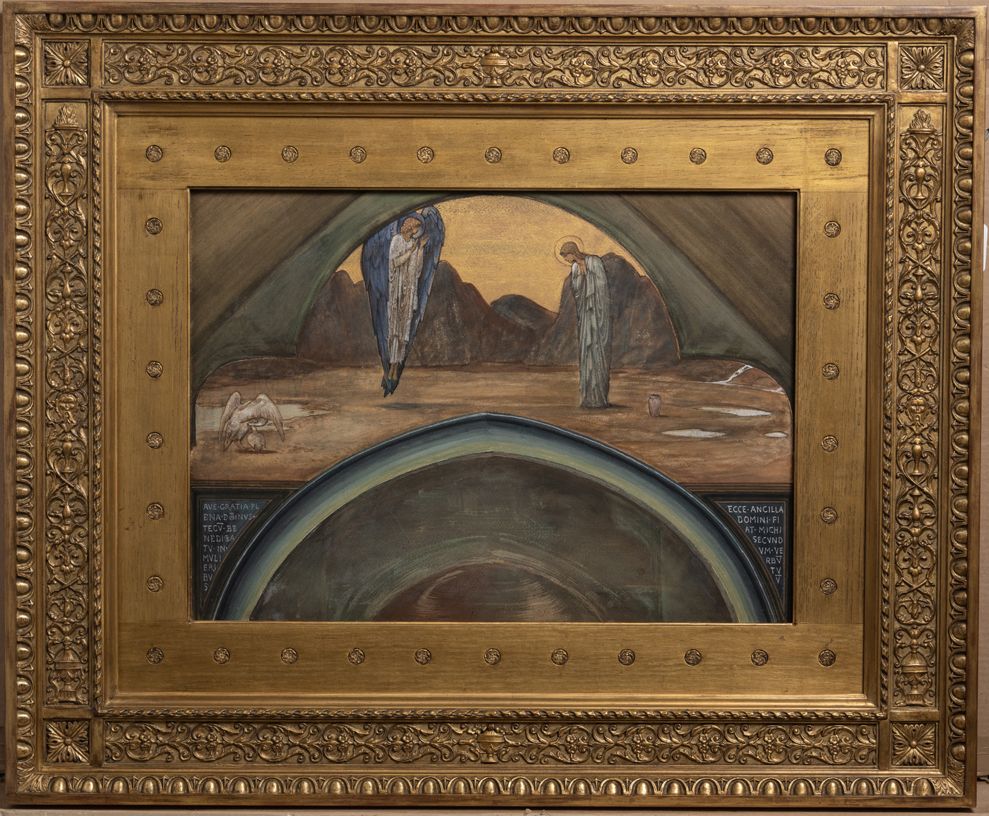Edward Coley Burne-Jones (1833–98)
The Annunciation, c. 1885
Bodycolor over pen and brown ink, with silver and gold paint with white heightening, on composition board
McMullen Museum of Art, Boston College, Gift of Alexandria & Michael Altman P’22, ’24, ’26 in memory of Father Michael J. Himes

Diana Larsen
Assistant Director, McMullen Museum

Often referred to as the “last pre-Raphaelite,” British artist Edward Coley Burne-Jones was both an accomplished painter and decorative designer. Frequently collaborating with his lifelong friend, William Morris (1834–96), he created designs for stained glass, textiles, and other furnishings. The Annunciation is a finished study for part of a cycle of mosaics commissioned for the American Episcopalian church in Rome, San Paolo dentro le Mura (St. Paul’s within the Walls, completed in 1880 (see photo), designed by British architect George Edmund Street (1824–81).
Inspired by sixth-century church mosaics the artist saw in Ravenna on his 1871 trip to Italy with the English critic and painter, John Ruskin, Burne-Jones’s mosaics designed for the Roman church decorate the chancel arches, the choir, and the apse. Their iconography progresses chronologically through the space: in the first arch the Annunciation, in the second Christ with arms outstretched in front of the Tree of Forgiveness flanked by Adam and Eve, and in the apse Christ in Glory with angels.
Burne-Jones sets The Annunciation in a mountainous desert under a reddening sky, a reference to the Marian prayer, the Angelus. Mary encounters the Archangel Gabriel while drawing water (suggested by the urn) from a spring. On the left, he includes a pelican piercing her breast to feed her young with her blood—a medieval symbol of Christ’s sacrifice not commonly depicted in Annunciation scenes. Burne-Jones was attracted to the pelican symbolism, including it in his 1880 design for a stained glass window in St. Martin’s Church, Brampton, Cumbria (see image). Burne-Jones separates Mary and the angel to accommodate the shape of the neo-Gothic arch. He adds Latin inscriptions referring to Mary in the lower corners in the study; they appear in the arch in the mosaic.
Throughout his life Burne-Jones painted many versions of the Annunciation. The elongated annunciating angel here is a departure from his earlier lifelike angels. A stylized figure with gold highlights in his hair and heart-shaped wings hovers and heralds the advent of symbolism in art—where spirituality and mysticism prevail. Burne-Jones became especially popular with French symbolists, who discovered his work at the 1889 Exposition Universelle in Paris.


